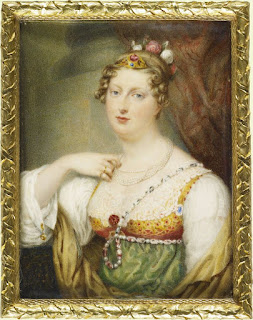Caroline of Brunswick, the Queen who was never Crowned
The greatest scandal of the entire Regency period was the behaviour of the Prince Regent towards his wife, Princess Caroline of Brunswick.
Caroline of Brunswick as a young woman
It was a scandal that went public and involved the entire nation rather like the unhappy marriage of Prince Charles to Lady Diana Spencer in our own time. Although she married the heir to the throne, Caroline, like Diana, was never crowned Queen. Her unjust treatment gained her the sympathy of women as different as Jane Austen - who wrote that she took sides with the Princess "because she is a woman" - and Elizabeth Craven, the Georgian feminist writer.
When Caroline was shipped over from Germany to marry George in 1795, he was aged 33 so he could hardly complain that she was 27. She had endured a very strict, confined upbringing which was certainly not the case with George. He was the most pampered, spoilt brat in the world and would have been a nightmare husband to any wife. From the age of eighteen, he had been leading the life of an idle and extravagant libertine, pursuing amusements in the fashionable world, running up debts and changing his mistress almost as often as the style of his cravat.
Georgie Porgie pudding and pie,
Kissed the girls and made them cry...
George was not entirely heartless - he seems to have genuinely lost his heart to Mrs Maria Fitzherbert, a hopelessly unsuitable attachment as she was a Catholic as well as a commoner. This made the secret marriage he entered into with her in 1785 doubly illegal. But though he had a heart, it was a fickle one. He conducted an on-off relationship with Maria and in between took a series of other mistresses, most of them married women such as Lady Melbourne... and Lady Jersey...and Lady Hertford...
Parliament of course did not recognize his secret marriage, and decreed that he must marry a suitable Protestant princess and produce an heir to the throne, if he wished to get his mounting debts paid. His cousin Caroline was the choice. George consented, but behaved in a way that looked like a colossal tantrum. Poor Caroline at her wedding was confronted by a surly, drunken bridegroom who complained that she was unattractive, and went to bed with her only under protest. As soon as she was pregnant - which was thankfully very soon - he went straight back to the arms of his mistress, and with disgusting manners even appointed Lady Jersey one of Caroline's official ladies in waiting. It was a public insult that humiliated his wife, and George deserved all the cruel caricatures and lampoons that were directed against him by the cartoonists of the time.
Contemporary caricature of George with one of his mistresses, Lady Hertford. Princess Caroline watches from the sidelines.
A year after the marriage, Caroline gave birth to a daughter, solving the problem of the succession, and George never lived with her again. He shunned her, holding court for all his chosen circle at Carlton House or the Brighton Pavilion while she lived at Kensington Palace, on a quite inadequate allowance. Far from her own home and family, and never really part of British society, she was a melancholy and pathetic figure, always glad to meet and mix with companions who spoke her native German.
George took his antipathy to such an extreme that he put spies on his wife's household, and in 1806 accused her of adultery. It was claimed that she had given birth to a secret illegitimate child! There was a public prosecution, and Caroline was vindicated.
When the Napoleonic wars ended, Caroline decided to take her household abroad and have a little fun. She travelled to Switzerland and Italy, where she got into a fair number of scrapes and employed as her chamberlain a handsome Milanese named Bergami, who was suspected of being her gigolo.
Caroline's daughter grew up to be the feminine image of her father. Princess Charlotte was every inch a Hanoverian: tall, blonde, generously built, with an aquiline nose and blue eyes.
She married Prince Leopold of Saxe-Coburg in 1816, and he came to England to act as her consort, but a year after the marriage she died in childbirth, and the child died too. It was a tragic outcome of her parents' tragic marriage.
When George III finally died in 1820, Caroline expected to be crowned Queen at last, but Georgie Porgie was equally determined that she would not. The most harrowing part of her marital ordeal was yet to come.
George once more attempted to divorce her on grounds of adultery, and she had to undergo a public trial in the House of Lords. Luckily she was acquitted, but nevertheless George, boorish to the last, locked her out of his coronation! This monstrous behaviour resulted in Caroline, who was already unwell, going into a fatal decline. She lived only a few more weeks.
When Caroline was going through this appalling treatment, Elizabeth Craven was one of the best friends she had. Why? Craven had endured an unhappy, arranged marriage for many years herself, and this gave her a particular sympathy for other women in the same predicament. Although she may have had little in common with Caroline, Princess of Wales, in any other respect, their tastes and temperament being poles apart, they certainly had this much in common and Craven went out of her way to make her solidarity with Caroline apparent. To her it was a matter of principle.
To find out more about Elizabeth Craven, her life, her writings, and exactly how she helped the unhappy Princess of Wales out of a terrible fix, read








Comments
Post a Comment